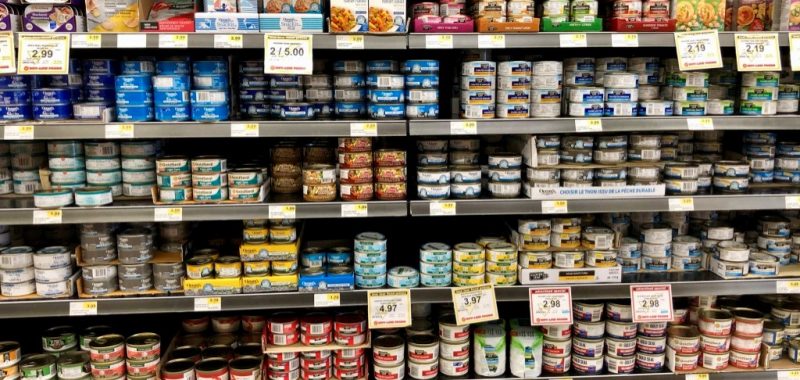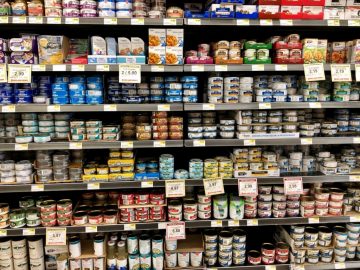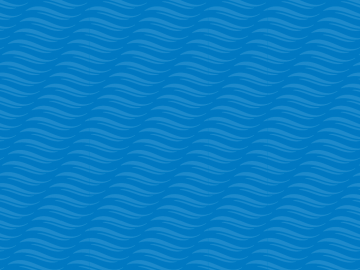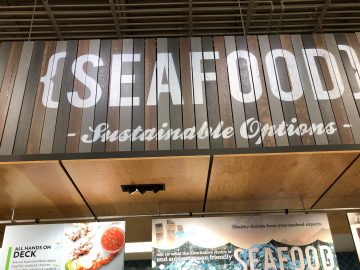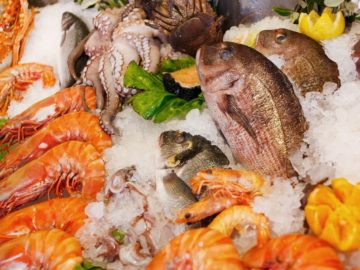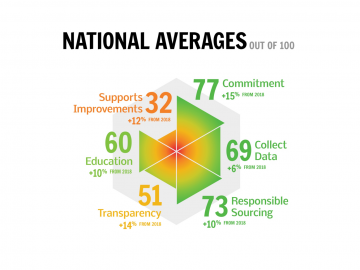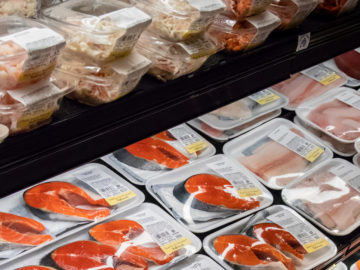It may be less than you think.
What if we told you that most Canadian retailers don’t include all of the seafood products sold in their stores in their sustainability commitments? It all comes down to the scope of their commitment.
Whether or not a certain seafood product falls under the retailer’s sustainability policy depends on three factors: the seafood’s brand type, the store department managing the product, and the “banner” of the store selling it. Using these factors, retailers will decide which products fall within the scope of their sustainability policies, and which ones are not covered. Let us explain.
Scope factor 1: Type of product brands
We’ll start by looking at the product brand types.
There are three types of product brands that retailers sell:
- Grocery store brands, or “private label” brands, which are owned by the retailer they are sold by (e.g. Loblaw’s President’s Choice, Sobeys’ Compliments, Costco’s Kirkland Signature);
- Seafood company brands, or “national brands”, which are companies that sell products across a range of businesses (e.g. Birds Eye, High Liner, Clover Leaf);
- Products with no brand are typically fresh, and sometimes frozen, products sold without any branding on the packaging (except perhaps for the logo of the store on the price label). Examples of “no brand” or “unbranded” products would be seafood you buy from your retailer’s fresh counter, such as fillets to order wrapped by a sales associate, or plastic-wrapped fillets on a Styrofoam or plastic tray.
Retailers have different levels of control over products of different brand types. They have a lot more control and decision-making power when it comes to their grocery store brands and the unbranded products because they work directly with suppliers or distributors to purchase these products. For important or high risk store-branded products, retailer’s involvement in the supply chain may start at the landing dock or fish farm.
Seafood companies, on the other hand, manage their brand’s supply chains and their agreements with suppliers. Although retailers have less direct control over where company-branded products come from or how they were produced, as major buyers of these products they have a lot of leverage to influence seafood companies’ practices. They just aren’t using it yet. One of the first steps in that direction is for retailers to include seafood company branded products in their seafood commitments, ensuring a level playing field across all of their products. Save-On-Foods’ and Walmart’s sustainable seafood commitments do not apply to the seafood company branded products, and Costco’s and Sobeys’ commitments do not apply to seafood company branded products or products with no brand.
Scope factor 2: Store department
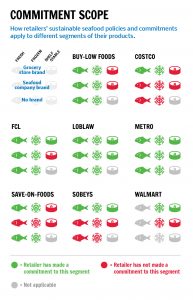
The department where you find seafood also matters. There are specific terms for the different categories of seafood that retailers sell, depending on how they are presented to the consumer and by which department. Fresh or frozen seafood is usually managed by a retailer’s meat (or sometimes “meat and seafood”) department. Canned, jarred, or pouched seafood that is stored at ambient room temperature is often referred to as “shelf stable”. These products don’t need to be refrigerated or frozen, and they are often managed by a retailer’s “grocery” department.
It’s important to know the difference between these types of products because retailers often use this language when describing their commitment. Sometimes only the “meat and seafood” department manages and follows the retailer’s commitments to sustainable seafood, while the “grocery” department of the same retailer does not. In these instances, the “meat and seafood” department will source fresh and frozen products (sometimes unbranded and private label only) in line with their commitments, but shelf-stable products, managed by “grocery”, may not be acquired in the same way. This is the case with Buy-Low Foods, Costco, Save-On-Foods and Sobeys.
Scope factor 3: Store brands (“banners”)
The store’s “banner” is one more dimension of the scope of a retailer’s commitment that determines which products are sourced according to the retailer’s seafood policy. Retailers frequently own multiple supermarket brands, called banners. For example, the retailer Loblaw owns the banners Atlantic Superstore, Extra Foods, Loblaws, Provigo, Real Canadian Superstore and Zehrs (among others). This can get very confusing, as sometimes multiple retailers have the rights to operate under the same banner, like with IGA. Only three IGAs in B.C. are owned by Sobeys – the rest of B.C.’s IGAs are owned by Georgia Main Food Group. To add further confusion, IGA stores in Quebec are managed by Sobeys Quebec, which operates independently from the national Sobeys. Alternatively, some retailers only operate banners under their name, such as Costco and Walmart. The following retailers do not require all of the banners they operate to adhere to their sustainable seafood policy: Buy-Low Foods (Budget Foods, Choices Market, Meinhardt Fine Foods, Quality Foods and Shop n’Save do not), Loblaw (Arz, Real Canadian Wholesale Club and T&T Supermarket do not), METRO (Marché Adonis does not) and Save-On-Foods (Bulkley Valley Wholesale, PriceSmart Foods and Urban Fare do not).
So, how can shoppers tell what is covered by their retailer?
Some retailers have information about the scope and limits of their sustainable seafood policy stated publicly and transparently – others are less clear. SeaChoice thinks that consumers should know whether the seafood they’re buying was sourced in accordance with a retailer’s commitment or not. We’ve developed an infographic that sums this up (see above) and scope information is included at the bottom of each retailers’ Seafood Progress profile overview page.
If you want your retailer to increase the scope of its seafood policy or commitment, please let them know by talking to an associate in-store, contacting their customer services department or using the Tweet buttons that are on each retailer’s profile page.
